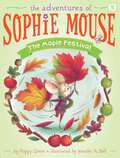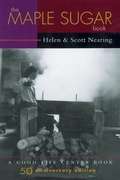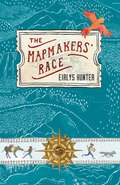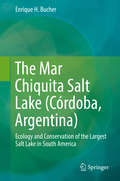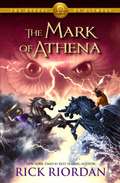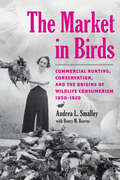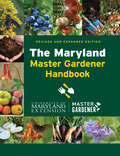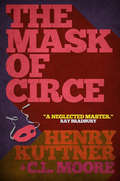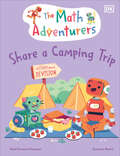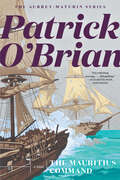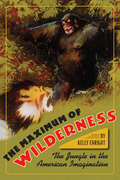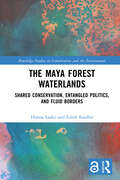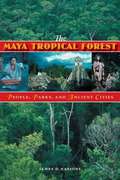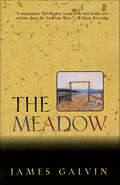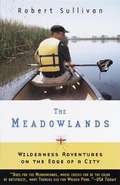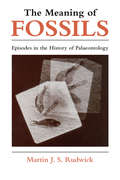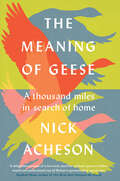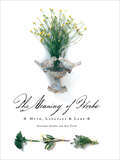- Table View
- List View
The Mangrove Tree: Planting Trees to Feed Families
by Susan L. Roth Cindy TrumboreFor a long time, the people of Hargigo, a village in the tiny African country of Eritrea, were living without enough food for themselves and their animals. Then along came a scientist, Dr. Gordon Sato, who helped to change their lives for the better. And it all started by planting some special mangrove trees. This fascinating story of environmental innovation is a celebration of creativity, hard work and the ability of one man to make a positive difference in the lives of many.
The Mangrove Tree: Planting Trees to Feed Families
by Susan L. Roth Cindy TrumboreThe fascinating story of Dr. Gordon Sato, who helped a small African village become self-sustaining by planting a forest of mangrove trees to reshape the community's ecosystem.For a long time, the people of Hargigo, a village in the tiny African country of Eritrea, were living without enough food for themselves and their animals. The families were hungry, and their goats and sheep were hungry too. Then along came a scientist, Dr. Gordon Sato, who helped change their lives for the better. And it all started with some special trees. These are the trees, Mangrove trees, That were planted by the sea. With alternating verse and prose passages, The Mangrove Tree invites readers to discover how Dr. Sato's mangrove tree-planting project transformed an impoverished village into a self-sufficient community. This fascinating story is a celebration of creativity, hard work-and all those mangrove trees that were planted by the sea!
The Manhattan Secret: An absolutely heartbreaking and gripping historical novel
by Marie-Bernadette DupuyAn absolutely heartbreaking and gripping historical novel based on a true story, for fans of Suzanne Goldring, Bridgerton and The Girl Behind the Gates.***FROM THE 4-MILLION COPY BESTSELLING AUTHOR******RATED 5 STARS BY REAL READERS***"A wonderfully romantic novel that will capitvate you instantly" -Hart, 5* Amazon reviewer"A fantastic story - I can't wait to read the next volume!" -Michele, 5* Amazon reviewerOctober 1886. Catherine and Guillaume Duquesne set off to New York with their six-year-old daughter Elisabeth. But the young couple's dreams of freedom and independence soon turn into a nightmare when Catherine dies during the journey and Guillaume is assaulted and left for dead soon after their arrival on American soil. A wealthy family adopts Elisabeth, who grows up spoiled and happy. But when she turns 16, she learns the truth about her origins and decides to return to France to meet her real family. Upon her arrival she realises that her grandfather's house, too, is seething with secrets...What readers think"The author is hugely talented." -Julie, 5* Amazon reviewer"Very attaching characters ... I'm impatient to read the next installment!" -5* Babelio reviewer"I just have to read the rest of the series." -Jean-Pierre, 5* fnac.com reviewer"Reads very well - wait until you read the ending!" -Françoise, 5* Amazon reviewer"An extraordinary author. I strongly recommend!" -Nathalie, 5* Amazon reviewer"I didn't know the author - it's an excellent novel. -Mimi, 5* Amazon reviewer
The Manhattan Secret: An absolutely heartbreaking and gripping historical novel
by Marie-Bernadette DupuyAn absolutely heartbreaking and gripping historical novel based on a true story, for fans of Suzanne Goldring, Bridgerton and The Girl Behind the Gates.***FROM THE 4-MILLION COPY BESTSELLING AUTHOR******RATED 5 STARS BY REAL READERS***"A wonderfully romantic novel that will capitvate you instantly" -Hart, 5* Amazon reviewer"A fantastic story - I can't wait to read the next volume!" -Michele, 5* Amazon reviewerOctober 1886. Catherine and Guillaume Duquesne set off to New York with their six-year-old daughter Elisabeth. But the young couple's dreams of freedomand independence soon turn into a nightmare when Catherine dies during the journey and Guillaume is assaulted and left for dead soon after their arrival on American soil. A wealthy family adopts Elisabeth, who grows up spoiled and happy. But when she turns 16, she learns the truth about her origins and decides to return to France to meet her real family. Upon her arrival she realises that her grandfather's house, too, is seething with secrets...What readers think"The author is hugely talented." -Julie, 5* Amazon reviewer"Very attaching characters ... I'm impatient to read the next installment!" -5* Babelio reviewer"I just have to read the rest of the series." -Jean-Pierre, 5* fnac.com reviewer"Reads very well - wait until you read the ending!" -Françoise, 5* Amazon reviewer"An extraordinary author. I strongly recommend!" -Nathalie, 5* Amazon reviewer"I didn't know the author - it's an excellent novel. -Mimi, 5* Amazon reviewer
The Maple Festival (The Adventures of Sophie Mouse #5)
by Poppy GreenSophie Mouse is so excited to help her mother bake treats for Silverlake Forest’s big Maple Festival in the fifth book of The Adventures of Sophie Mouse.It’s finally fall in Silverlake Forest, and that means it’s time for the annual Maple Festival! The animals have heard it is going to be the biggest one yet with games, rides and, of course, Lily Mouse’s famous maple-filled bake-stand. Sophie is delighted when her mother asks for her help baking the goodies for the festival. When they get there, Sophie runs off to play with her friends…until she notices that no one has come to her mother’s stand! Can she use some quick thinking and her artistic skills to draw customers in? With easy-to-read language and illustrations on almost every page, the Adventures of Sophie Mouse chapter books are perfect for beginning readers.
The Maple Sugar Book
by Helen Scott NearingA half-century ago, the world was trying to heal the wounds of global war. People were rushing to make up for lost time, grasping for material wealth. This was the era of "total electric living," a phrase beamed into living rooms by General Electric spokesman Ronald Reagan. Environmental awareness was barely a gleam in the eye of even Rachel Carson. And yet, Helen and Scott Nearing were on a totally different path, having left the city for the country, eschewing materialistic society in a quest for the self-sufficiency they deemed "the Good Life. " Chelsea Green is pleased to honor their example by publishing a new edition of "The Maple Sugar Book", complete with a new section of never-before-published photos of the Nearings working on the sugaring operation, and an essay by Greg Joly relating the story behind the book and placing the Nearings' work in the context of their neighborhood and today's maple industry. Maple sugaring was an important source of cash for the Nearings, as it continues to be for many New England farmers today. This book is filled with a history of sugaring from Native American to modern times, with practical tips on how to sap trees, process sap, and market syrup. In an age of microchips and software that are obsolete before you can install them, maple sugaring is a process that's stood the test of time. Fifty years after its original publication in 1950, "The Maple Sugar Book" is as relevant as ever to the homestead or small-scale commercial practitioner.
The Mapmakers' Race
by Eirlys HunterFive children find a route through the wilderness in this exciting mountain-race adventure for middle grade readers. Sal, Joe, Francie and Humphrey misplace their famous mapmaker mother as they begin the Great Race to map a rail route through an uncharted wilderness. Their father didn't return from his last expedition and now their money is gone. This race is their last chance. They have 28 days to find and map the best route. There'll be bears, bees, bats, river crossings, cliff falls, impossible weather—but worst of all, they're racing five teams of adults who do not play by the rules.
The Mar Chiquita Salt Lake (Córdoba, Argentina): Ecology and Conservation of the Largest Salt Lake in South America
by Enrique H. BucherThis book provides a comprehensive, updated syntheses of all the information available on Mar Chiquita, covering various aspects of the geography, geological history, biology and ecology of the site, as well as a detailed analysis of the current land-use patterns, environmental threats, and conservation issues. Mar Chiquita, located in the province of Cordoba, Argentina, is a protected wilderness area that includes South America’s largest saline lake and wetland. It has a very rich bird biodiversity, including three of the six species of flamingos that exist in the world, and high numbers of intercontinental migratory shorebirds. For this reason, the area has been declared an International Site by the Ramsar Convention on Wetlands of International Importance, and also a Site of Hemispheric Importance by the Western Hemisphere Shorebird Reserves Network. Largely unknown until very recently, particularly in terms of the English literature, the site is rapidly gaining international visibility, not only in terms of scientific research, but also as site of interest for the nature lovers around the globe. Written in a language accessible to the non-specialists, the book focuses on integrating the dynamic, functional processes in the ecosystem, while at the same time providing the necessary descriptive information. Accordingly, it is of interest to scientists from diverse disciplines interested in saline wetlands, as well as to students, managers, and the general public.
The Mark of Athena (The Heroes of Olympus #3)
by Rick RiordanThe Greek and Roman demigods will have to cooperate in order to defeat the giants released by the Earth Mother, Gaea. Then they will have to sail together to the ancient land--Greece itself--to find the Doors of Death.
The Market in Birds: Commercial Hunting, Conservation, and the Origins of Wildlife Consumerism, 1850–1920
by Andrea L. SmalleyA fascinating look at how a commercial market for birds in the late nineteenth century set the stage for conservation and its legislation.Between the end of the Civil War and the 1920s, the United States witnessed the creation, rapid expansion, and then disappearance of a commercial market for hunted wild animals. The bulk of commercial wildlife sales in the last part of the nineteenth century were of wildfowl, who were prized not only for their eggs and meat but also for their beautiful feathers. Wild birds were brought to cities in those years to be sold as food for customers' tables, decorations for ladies' hats, treasured pets, and specimens for collectors' cabinets. Though relatively short-lived, this market in birds was broadly influential, its rise and fall coinciding with the birth of the Progressive Era conservation movement. In The Market in Birds, historian Andrea L. Smalley and wildlife biologist Henry M. Reeves illuminate this crucial chapter in American environmental history. Touching on ecology, economics, law, and culture, the authors reveal how commercial hunting set the terms for wildlife conservation and the first federal wildlife legislation at the turn of the twentieth century. Smalley and Reeves delve into the ground-level interactions among market hunters, game dealers, consumers, sportsmen, conservationists, and the wild birds they all wanted. Ultimately, they argue, wildfowl commercialization represented a revolutionary shift in wildlife use, turning what had been a mostly limited, local, and seasonal trade into an interstate industrial-capitalist enterprise. In the process, it provoked a critical public debate over the value of wildlife in a modern consumer culture. By the turn of the twentieth century, the authors reveal, it was clear that wild bird populations were declining precipitously all over North America. The looming possibility of a future without birds sparked intense debate nationwide and eventually culminated in the 1918 Migratory Bird Treaty Act. Scholars, environmentalists, wildlife professionals, and anyone concerned about wildlife will find this new perspective on conservation history enlightening reading.
The Marksmanship Primer: The Experts' Guide to Shooting Handguns and Rifles
by Jim CasadaThe Marksmanship Primer serves as a roadmap to greater shooting proficiency as well as greater enjoyment of the sport of shooting. Jim Casada, renowned outdoors author and editor, has brought together the best selections from America's great gun writers of yesterday and today. Marksmen of all levels of experience—beginners, pros, and hobbyists—can benefit from this collection of shooting wisdom.Topics include:Positions for Rifle and Handgun ShootingSighting InBallisticsRifle Marksmanship for the HunterAccuracy at All DistancesHunting with the HandgunPhysical and Mental Fitness for the MarksmanAchieving accuracy and a high degree of competence is an immediate joy; refining it through regular trips to the range or the field can provide a lifetime of pleasure. The Marksmanship Primer is the best book to seek hunting and target shooting knowledge.
The Marrow Thieves
by Cherie DimalineShortlisted for CBC Canada Reads in 2018Winner of the 2017 Governor General's Literary Award (Young People's Literature - Text)Winner of the 2017 Kirkus PrizeWinner of the 2018 Burt Award for First Nations, Inuit and Métis Young Adult LiteratureWinner of the 2018 Amy Mathers Teen Book AwardWinner of the 2018 Sunburst Award for Excellence in Canadian Literature of the FantasticA Globe and Mail Best Book"A timely and necessary read ... powerful and endlessly smart, it's a crucial work of fiction for people of all ages." Starred Review - Quill & Quire Humanity has nearly destroyed its world through global warming, but now an even greater evil lurks. The indigenous people of North America are being hunted and harvested for their bone marrow, which carries the key to recovering something the rest of the population has lost: the ability to dream. In this dark world, Frenchie and his companions struggle to survive as they make their way up north to the old lands. For now, survival means staying hidden - but what they don't know is that one of them holds the secret to defeating the marrow thieves.
The Maryland Master Gardener Handbook
by University of Maryland Extension - Master Gardener ProgramThe definitive guide to gardening in Maryland and the mid-Atlantic—from the experts at the University of Maryland Extension.Whether you're a novice or an expert gardener, The Maryland Master Gardener Handbook is the resource you need to grow a thriving garden in Maryland and the mid-Atlantic region. This reference details plant terminology, gardening instructions, growing schedules, and species charts featuring color photographs for gardeners in Maryland.Chapters cover essential horticultural topics such as ecology, botany, soils, entomology, and plant diseases. In addition to educating gardeners about the basics, the handbook highlights sustainable gardening content such as the use and care of native plants, integrated pest management, water conservation, and best management practices for gardening in a changing climate. Diving deeper, the handbook also provides information on:• Plant nutrition• Composting and pruning• Weeds and lawns• Herbaceous plants and woody plants• Vegetables and fruits• Native plants, invasive plants, indoor plants, and plant propagation• Landscape design and conservation landscaping• Wildlife and woodlands• Garden tools and equipmentFinally, the guide includes diagnostic keys for all major plant groups and special keys for cultural and environmental problems, as well as information on structural and nuisance pests. Created as part of the curriculum of the University of Maryland Extension Master Gardener Program, The Maryland Master Gardener Handbook is the definitive resource for anyone looking to develop a green thumb.
The Mask of Circe
by Henry Kuttner C.L. MooreA psychiatrist travels to a world of magic and gods in this take on &“Jason and the Argonauts&” from the Hugo Award–nominated author of Earth&’s Last Citadel. Jay Seward remembers a former life in a land of magic, gods, and goddesses—a time when he was Jason of Iolcus, sailing in the enchanted ship Argo to steal the Golden Fleece from the serpent-temples of Apollo. But one night the memories become startlingly real, as the Argo itself sails out of the spectral mists and a hauntingly beautiful voice calls: &“Jason . . . come to me!&” And suddenly he&’s on the deck of the Argo, sailing into danger and magic . . . &“A fantasy in the grand tradition of Merritt and the other giants.&” —Arthur Leo Zagat, author of the Tomorrow series Praise for Henry Kuttner &“One of the all-time major names in science fiction.&” —The New York Times &“A neglected master.&” —Ray Bradbury, author of Fahrenheit 451 &“Kuttner is magic.&” —Joe R. Lansdale, author of The Thicket
The Mason Jar Scientist: 30 Jarring STEAM-Based Projects
by Brenda PriddyFun, STEAM-based experiments and activities to do at home—all within a mason jar! Scientific learning doesn't have to stop when kids hop off the school bus. With The Mason Jar Scientist, you and your kids can have a blast together while learning about fascinating scientific topics! This book provides dozens of practical, hands-on experiments illustrating scientific principles—that can all be done within a mason jar. Each experiment also includes discussion questions and great ideas for STEAM-based extension activities. You and your child will learn about: Clouds Why the sky is blue Tornadoes The greenhouse effect Light refraction Sound vibrations The solar system Biomes And much more! All you need for each activity is a mason jar, some household ingredients, and a desire to learn! Packed with colorful photos, clear, information, and easy-to-follow instructions, The Mason Jar Scientist is the perfect book to get kids excited about science and to spend some quality time together.
The Math Adventurers Share a Camping Trip: A Story About Division (The Math Adventurers)
by Sital Gorasia ChapmanJoin two friendly and funny robots, Beep and Boots, as they learn all about division and discover that math is everywhere they look.Beep and Boots are going on a camping trip in the great outdoors. They've got a warm sleeping bag each, a snuggly blanket each, and marshmallows to share. But they realize there are not enough tent pegs! Can they learn to divide up what they have and put up their tents before it's time for bed?Characterful illustrations and rhyming text bring Beep and Boots to life. Children ages 5-7 will love seeing the adventures the robot duo go on and will learn key mathematical concepts concerning division in a gentle, fun way. A visual glossary and math questions at the end of the book reinforce learning and encourage kids to look at the math they can see in the world around them.
The Mauritius Command (Aubrey/Maturin Novels #Vol. Book 4)
by Patrick O'BrianCaptain Jack Aubrey is ashore on half pay without a command—until Stephen Maturin arrives with secret orders for Aubrey to take a frigate to the Cape of Good Hope under a commodore's pennant, there to mount an expedition against the French-held islands of Mauritius and La Réunion. But the difficulties of carrying out his orders are compounded by two of his own captains—Lord Clonfert, a pleasure-seeking dilettante, and Captain Corbett, whose severity pushes his crew to the verge of mutiny.
The Maximum of Wilderness: The Jungle in the American Imagination
by Kelly EnrightDanger in the Congo! The unexplored Amazon! Long perceived as a place of mystery and danger, and more recently as a fragile system requiring our protection, the tropical forest captivated America for over a century. In The Maximum of Wilderness, Kelly Enright traces the representation of tropical forests--what Americans have typically thought of as "jungles"--and their place in both our perception of "wildness" and the globalization of the environmental movement.In the early twentieth century, jungle adventure--as depicted by countless books and films, from Burroughs’s Tarzan novels to King Kong--had enormous mass appeal. Concurrent with the proliferation of a popular image of the jungle that masked many of its truths was the work of American naturalists who sought to represent an "authentic" view of tropical nature through museums, zoological and botanical gardens, books, and film. Enright examines the relationship between popular and scientific representations of the forest through the lives and work of Martin and Osa Johnson (who with films such as Congorilla and Simba blended authenticity with adventure), as well as renowned naturalists John Muir, William Beebe, David Fairchild, and Richard Evans Schultes. The author goes on to explore a startling shift at midcentury in the perception of the tropical forest--from the "jungle," a place that endangers human life, to the "rain forest," a place that is itself endangered.
The Maya Forest Waterlands: Shared Conservation, Entangled Politics, and Fluid Borders (Routledge Studies in Conservation and the Environment)
by Hanna Laako Edith KaufferThis book examines the entanglements and blurred edges of nature conservation and geopolitical relations in the borderlands of the trinational Maya Forest.Maya Forest is an umbrella term for transboundary conservation developed by scientists and conservationists in the 1990s to protect the threatened rainforest in the borderlands of Mexico, Belize, and Guatemala. Currently, the Maya Forest is a biodiversity hotspot composed of a network of protected areas and heritage sites. However, issues related to water, land, and forests have often been treated as separate political units, and not as part of the same history. Written by two authors with decades of hands-on experience in this region, this book sheds light on the complex dynamics by which conservation and natural resource management geopolitically shape borderlands such as the Maya Forest. The book introduces the novel concept of forest waterlands as borderlands and fluid edges, which are now subject to concern by conservationists. These are entangled spaces in which conservation, peoples, and politics interact, connect, and disconnect with the nexus of waters, forests, and lands. The book sheds light on the building and mapping of the Maya Forest ecoregion, with particular attention to water as an often neglected, but unifying element. It showcases how the Maya Forest is a distinct region characterized by transformations entangled with the Maya, trails of biological stations, the shared history of chicleros (chewing-gum hunters), fluid international rivers and transboundary basins, and various geopolitical discrepancies. It offers a contemporary glimpse into the Maya Forest’s intertwined bio- and geopolitics, which urge us to rethink borders and boundaries.This book will be of great interest to students and scholars of nature conservation, global environmental politics, geopolitics, borderlands, international relations, and natural resource management.
The Maya Tropical Forest: People, Parks, and Ancient Cities
by James D. NationsThe Maya Tropical Forest, which occupies the lowlands of southern Mexico, Guatemala, and Belize, is the closest rainforest to the United States and one of the most popular tourist destinations in the Western Hemisphere. It has been home to the Maya peoples for nearly four millennia, starting around 1800 BC. Ancient cities in the rainforest such as Palenque, Yaxchilan, Tikal, and Caracol draw thousands of tourists and scholars seeking to learn more about the prehistoric Maya. Their contemporary descendants, the modern Maya, utilize the forest's natural resources in village life and international trade, while striving to protect their homeland from deforestation and environmental degradation. Writing for both visitors and conservationists, James Nations tells the fascinating story of how ancient and modern Maya peoples have used and guarded the rich natural resources of the Maya Tropical Forest. He opens with a natural history that profiles the forest's significant animals and plants. Nations then describes the Maya peoples, biological preserves, and major archaeological sites in Mexico, Guatemala, and Belize. Drawing on more than twenty-five years of conservation work in the Maya Tropical Forest, Nations tells first-hand stories of the creation of national parks and other protected areas to safeguard the region's natural resources and archaeological heritage. He concludes with an expert assessment of the forest's future in which he calls for expanded archaeological tourism to create an ecologically sustainable economic base for the region.
The Meadow
by James GalvinAn American Library Association Notable BookIn discrete disclosures joined with the intricacy of a spider's web, James Galvin depicts the hundred-year history of a meadow in the arid mountains of the Colorado/Wyoming border. Galvin describes the seasons, the weather, the wildlife, and the few people who do not possess but are themselves possessed by this terrain. In so doing he reveals an experience that is part of our heritage and mythology. For Lyle, Ray, Clara, and App, the struggle to survive on an independent family ranch is a series of blameless failures and unacclaimed successes that illuminate the Western character. The Meadow evokes a sense of place that can be achieved only by someone who knows it intimately.
The Meadowlands: Wilderness Adventures at the Edge of a City
by Robert SullivanThe author, a journalist and urban explorer, describes the New Jersey Meadowlands, a sprawling marsh just west of Manhattan. Once logged for cedar, later the site of pig farms, the Meadowlands became a vast garbage dump. Unknown numbers of human bodies have disappeared into its mud, including, according to some, that of Teamsters' boss, Jimmy Hoffa. The author weaves stories of the area's colorful past with tales of his own explorations and encounters.
The Meaning of Fossils: Episodes in the History of Palaeontology
by Martin J.S. Rudwick"It is not often that a work can literally rewrite a person's view of a subject. And this is exactly what Rudwick's book should do for many paleontologists' view of the history of their own field."—Stephen J. Gould, Paleobotany and Palynology "Rudwick has not merely written the first book-length history of palaeontology in the English language; he has written a very intelligent one. . . . His accounts of sources are rounded and organic: he treats the structure of arguments as Cuvier handled fossil bones."—Roy S. Porter, History of Science
The Meaning of Geese: A Thousand Miles in Search of Home
by Nick Acheson‘A magisterial diary for bird lovers.’ Observer ⭐⭐⭐⭐ The Telegraph As seen on BBC Winterwatch 2023 ‘Honest, human and heart-grabbing. I loved this book so much.’ Sophie Pavelle, author of Forget Me Not ‘Delightful’ Stephen Moss, author of Ten Birds that Changed the World ‘Fascinating and thought-provoking’ Jake Fiennes, author of Land Healer ‘Awe-filled and absorbing’ Nicola Chester, author of On Gallows Down The Meaning of Geese is a book of thrilling encounters with wildlife, of tired legs, punctured tyres and inhospitable weather. Above all, it is the story of Nick Acheson’s love for the land in which he was born and raised, and for the wild geese that fill it with sound and spectacle every winter. Renowned naturalist and conservationist Nick Acheson spent countless hours observing and researching wild geese, transported through all weathers by his mother’s 40-year-old trusty red bicycle. He meticulously details the geese’s arrival, observing what they mean to his beloved Norfolk and the role they play in local people’s lives – and what role the birds could play in our changing world. During a time when many people faced the prospect of little work or human contact, Nick followed the pinkfeet and brent geese that filled the Norfolk skies and landscape as they flew in from Iceland and Siberia. In their flocks, Nick encountered rarer geese, including Russian white-fronts, barnacle geese and an extremely unusual grey-bellied brant, a bird he had dreamt of seeing since thumbing his mother’s copy of Peter Scott’s field guide as a child. To honour the geese’s great athletic migrations, Nick kept a diary of his sightings as well as the stories he discovered through the community of people, past and present, who loved them, too. Over seven months Nick cycles over 1,200 miles – the exact length of the pinkfeet’s migration to Iceland.
The Meaning of Herbs: Myth, Language & Lore
by Ann Field Gretchen ScobleThe fascinating history and uses of these versatile botanicals through the ages, from love potions to self-care—from the authors of The Meaning of Flowers. &“Take borage for courage. Send a bouquet of yarrow to declare war. Hang a sprig of rue at the door to keep witches at bay.&” Like flowers, herbs are steeped in myth and magic, secrets and lore. For centuries, their powers have been called upon to seduce lovers and dispel witches, send hidden messages and brew potent elixirs, entice the palate and soothe the mind. Illustrated with enchanting collages by acclaimed artist Ann Field, this delightful tribute to the meaning and magic of herbs offers a contemporary introduction to an age-old tradition. The text draws on botanical, mythological, and historical sources worldwide, from ancient Rome to Victorian England, from Asia to the Americas, presenting profiles of over fifty herbs favored through the ages. Blending fact, folktale, natural history, and original art, The Meaning of Herbs explores the language and lore of nature&’s most versatile and powerful gifts.



